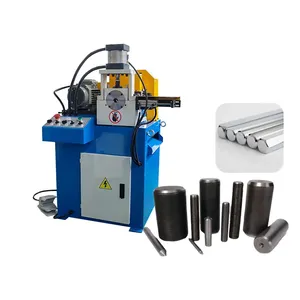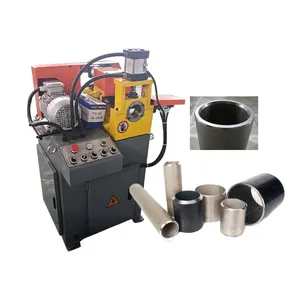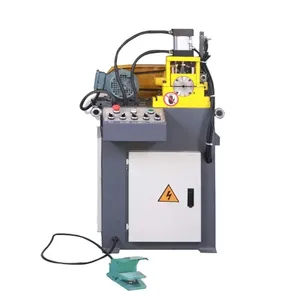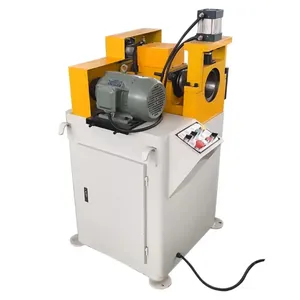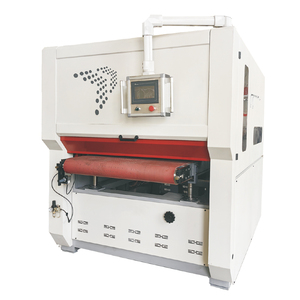Types of chamfering deburring machines
There are different types of chamfering deburring machines that perform deburring and chamfering operations on various types of workpieces. Some of the machines are manual models with cranks that provide power to the machine. They are generally safe to operate, and untrained personnel can use them. Other types of machines are electrically powered and equipped with features like variable speed settings that allow them to deburr and chamfer workpieces more effectively. The following deburring and chamfering machines will be discussed:
- Deburring Tapping Machine: This machine is like a standard tapping machine and is used to chamfer or remove burrs from the inside of holes. It uses a tap to cut the edges of workpieces, and due to its similarity with a standard tapping machine, operators and workers can easily use it without extensive training.
- Manual Deburring Machine with Crank: These machines require manual input, usually with the help of a crank. They are used to remove burrs or chamfer the edges of workpieces. Since they don't require electrical power to operate, they can be used in areas far away from any power source.
- Plate Edge Deburring Machine: These machines are specialized machines that are specifically designed to deburr the edges of workpieces and are suitable for deburring different thicknesses. Due to their design, they can process up to 5mm of thickness, including stainless steel and aluminum plates.
- Power Skiving Deburring Tool: Also known as the chamfering and deburring tool, this cutting tool is attached to a milling machine's spindle. It consists of a cylindrical body that has cutting edges and inserts located at the top. When the spindle is rotated, the tool starts to perform deburring operations, removing sharp edges from the sides of openings and providing a uniform shape with rounded edges or corners.
- Rotary Deburring Tool: This tool is the most common in manual kits. It usually has one or two small wheels and an arbor, and it is used to remove burrs and smooth edges of various types of workpieces. The tool is fitted into a handheld drill, a grinder, or an electric screwdriver, and upon powering the device, the rotary tool spins. As it spins at a high speed, it rubs against the burr and removes it by grinding it away.
Specification and maintenance of chamfering deburring machines
Specifications of chamfering and deburring machines may vary depending on the model and type. Here are some common specifications for these machines:
- Different types: The types of chamfering and deburring machines can vary, including manual, electric, ultrasonic, and so on, which may suit different industries and materials.
- Different surface treatment methods: Some of these machines feature sandblasting processes, while others employ polishing techniques, resulting in diverse final surface finishes.
- Workpiece size and weight: In this regard, capacity specifications for chamfering and deburring machines typically indicate the maximum dimensions and weight of workpieces the machine can accommodate.
- Power and speed: The power and speed of chamfering and deburring machines can vary according to models. This affects the machining efficiency and surface treatment results of the workpieces.
- Function: These machines' functions include deburring, chamfering, and edge rounding. Certain models and types may also offer additional features like surface polishing and groove processing.
- Accessories: Depending on the model, some machines may come with extra attachments, such as different types and specifications of brushes, which allow for more flexible processing and handling of workpieces.
It's crucial to note that the above specifications are representative and not exhaustive. The precise specifications of a particular type of chamfering and deburring machine should be confirmed according to its product manual or manufacturer description.
Additionally, maintaining chamfering and deburring machines appropriately can ensure proper functioning and prolong their lifespan. Maintenance tips are as follows:
- Cleaning: Regularly clean the machine's surfaces and parts using a brush or compressed air to remove debris and dust. At the same time, consider cleaning the cleaning solution or degreaser for better results.
- Lubrication: Components like guide rails, bearings, and gearboxes are to be lubricated with lubricant or lubricating oil. This practice may facilitate smooth component operations while decreasing friction and abrasion, thereby helping to avert early damage.
- Replace wearing parts: The chamfering and deburring machines are to be equipped with some friction and impact, such as brushes, cutting heads, blades, etc. Their longevity may be limited due to constant use; thus, it is necessary to replace them regularly as needed to ensure the machines perform optimally and maintain a high standard of operation.
- Electrical maintenance: Pay attention to the machine's electrical parts, including power cords, switches, and more. Check the connection and insulation of the wires and ensure the switch is in proper working order, thus avoiding potential safety hazards.
- Debugging and adjustment: Regularly debug and adjust the machine according to the instructions to ensure its various performance parameters are within the appropriate range, thereby ensuring proper operation and processing quality.
Scenarios
- Automotive Industry: In the automotive industry, chamfering machines deburring plays a vital role in ensuring smooth edges and ensuring that the automotive components comply with the set industry standards. Deburring and chamfering are carried out on different parts of the automotive industry/assembly, such as the body, brakes, engines, transmissions, and suspension. By using deburring machines, automotive manufacturers can enhance the performance of automotive parts and eliminate assembly issues that arise from jagged or rough edges.
- Aerospace Industry: The aerospace industry places high value on deburring and chamfering machines to enhance the quality, performance, and safety of aircraft. These machines play a pivotal role in the efficient processing of delicate and lightweight materials, such as titanium, carbon fiber, and aluminum alloys. The precision of deburring and chamfering machines is crucial for attaining a perfect match of tolerances, smooth edges, and assembly parts in aerospace components like landing gear, fuselage, turbine blades, and airframes.
- Electronics Industry: In the electronics industry, deburring and chamfering machines are essential for achieving the precise tolerances and smooth edges necessary for assembling delicate electronic devices like smartphones, tablets, computers, and circuit boards. Without these machines, the assembly of electronic devices would be almost impossible due to the presence of jagged and rough edges making it difficult to achieve a perfect fit. Instead, deburring and chamfering machines enable electronic manufacturers to produce high-quality devices with smooth and efficient assembly.
- Medical Industry: In the medical industry, precision instruments and implants like catheters, scalpel blades, stents, and orthopedic devices require a burr-free and smooth-edged finish for optimal performance and patient safety. Deburring and chamfering machines offer an ideal solution for achieving these high-quality standards. These machines can process even the most complex microstructures found in medical devices. As a result, they play a vital role in the healthcare industry by ensuring that medical instruments and implants meet the strict quality and safety requirements demanded by regulatory agencies and healthcare professionals.
- Robotics and Automation: In the field of robotics and automation, precision and smoothness are crucial for optimal functioning. This is particularly true in high-stress areas such as joints and coupling mechanisms. A roughness and burr present in these areas can lead to friction and premature wear, eventually resulting in malfunction. Deburring and chamfering machines are vital in eliminating burrs and rough edges in robotic components, thereby enhancing their longevity and reliability. By using these machines, robotic engineers can ensure that their creations function smoothly, efficiently, and for an extended period.
How to choose chamfering deburring machines
A few factors about the functionality, efficiency, purpose, and features of the chamfering and deburring machines should be taken into account when buying them:
-
Operation:
Focus on whether the machine is manual, pneumatic, electric, or whether it is running on some other engine.
-
Functionality:
It is important to check what functions the machine performs apart from chamfering and deburring, such as polishing, grinding, etc.
-
Tooling:
Consider the types and qualities of tools used in the deburring machines, such as blades, burrs, router bits, etc. Specialized tools often provide better results.
-
Adaptability:
Whether the chamfering machine can process complex shapes or change tools for different tasks is also important, such as dealing with irregular shapes, switching between burrs and blades.
-
Quality:
Last but not least, examine the overall build quality, including the materials and construction techniques used. High-quality machines are often less prone to failure and require less frequent maintenance.
-
Automation:
Automation level plays a pivotal role in determining a machine's efficiency and operational complexity. Whether the machine is manually operated, semi-automated, or fully automated significantly affects production volume and labor requirements.
Q&A
Q: What is the difference between deburring and chamfering?
A: The process of deburring removes sharp edges and imperfections from newly manufactured parts. Chamfering is the process of creating a shallow linear depression or groove along the edge of a material, usually for aesthetic purposes.
Q: Are chamfering machines CNC?
A: Yes. Computer numerical control (CNC) chamfering machines are designed to create precise chamfers on various materials. These machines are usually programmed to create specific chamfer sizes and angles for different workpieces, bringing accuracy to the industry.
Q: Can a deburring machine improve the safety of handled parts?
A: Yes. Deburring machines can improve the safety of handled parts. Burrs are often sharp and can easily cut a person's hand. Removing them with a chamfering/deburring machine will improve the safety of handled parts.
Q: Can a deburring machine improve the component's performance?
A: Yes. Burrs can adversely affect a component's performance by impeding the fitting of moving parts, causing excessive wear, and making part assembly difficult. A deburring machine will ensure component optimal performance.
















































































































